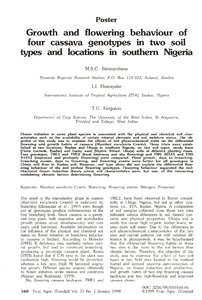| dc.contributor.author | Simwambana, M.S.C. |
| dc.contributor.author | Ekanayake, I.J. |
| dc.contributor.author | Ferguson, T.U. |
| dc.date.accessioned | 2019-12-04T11:09:00Z |
| dc.date.available | 2019-12-04T11:09:00Z |
| dc.date.issued | 1998 |
| dc.identifier.citation | Simwambana, M.S.C., Ekanayake, I.J. & Ferguson, T.U. (1998).Growth and flowering behavior of four cassava genotypes in two soil types and locations in southern Nigeria. Tropical Agriculture (Trinidad) 75(1): 160-165. |
| dc.identifier.issn | 0041-3216 |
| dc.identifier.uri | https://hdl.handle.net/20.500.12478/1955 |
| dc.description.abstract | Flower initiation in some plant species is associated with the physical and chemical soil characteristics such as the availability of certain mineral elements and soil moisture status. The objective of this study was to examine the effects of soil physicochemical traits on the differential flowering and growth habits of cassava (Manihot esculenta Crantz). Three trials were established at two locations, Ibadan and Ubiaja in southern Nigeria, on two soil types, sandy loam (Ferric Luvisols, Ibadan) and loamy sand (Dystric Nitisol, Ubiaja) soils at different planting times. Four genotypes, TMEI and TME2 (local landraces and shy flowering) and TMS 30555 and TMS 91934 (improved and profusely flowering) were compared. Plant growth, days to branching, branching events, days to flowering, and flowering events were better for all genotypes in Ubiaja soil than in Ibadan soil. However, soil type alone did not explain the differential flowering behaviour of shy and profuse flowering genotypes. Flowering behaviour supported the multifactorial flower induction theory where soil characteristics were, but one, of the interacting modulating climatic factors determining flowering. |
| dc.format.extent | 160-165 |
| dc.language.iso | en |
| dc.subject | Manihot Esculenta |
| dc.subject | Cassava |
| dc.subject | Branching |
| dc.subject | Flowering |
| dc.subject | Nitrogen |
| dc.subject | Potassium |
| dc.subject | Genotypes |
| dc.subject | Soil Type |
| dc.subject | Flowering |
| dc.title | Growth and flowering behavior of four cassava genotypes in two soil types and locations in southern Nigeria |
| dc.type | Journal Article |
| dc.description.version | Peer Review |
| cg.contributor.affiliation | Mutanda Regional Research Station |
| cg.contributor.affiliation | International Institute of Tropical Agriculture |
| cg.contributor.affiliation | University of the West Indies |
| cg.coverage.region | Africa |
| cg.coverage.region | West Africa |
| cg.coverage.country | Nigeria |
| cg.isijournal | ISI Journal |
| cg.authorship.types | CGIAR and advanced research institute |
| cg.iitasubject | Cassava |
| cg.iitasubject | Genetic Improvement |
| cg.iitasubject | Plant Genetic Resources |
| cg.iitasubject | Plant Production |
| cg.journal | Tropical Agriculture |
| cg.howpublished | Formally Published |
| cg.accessibilitystatus | Limited Access |
| local.dspaceid | 85261 |
| cg.targetaudience | Scientists |

